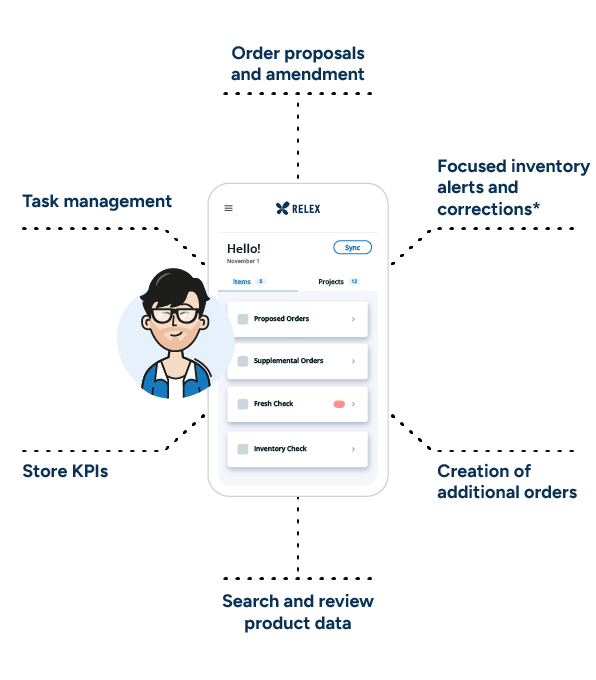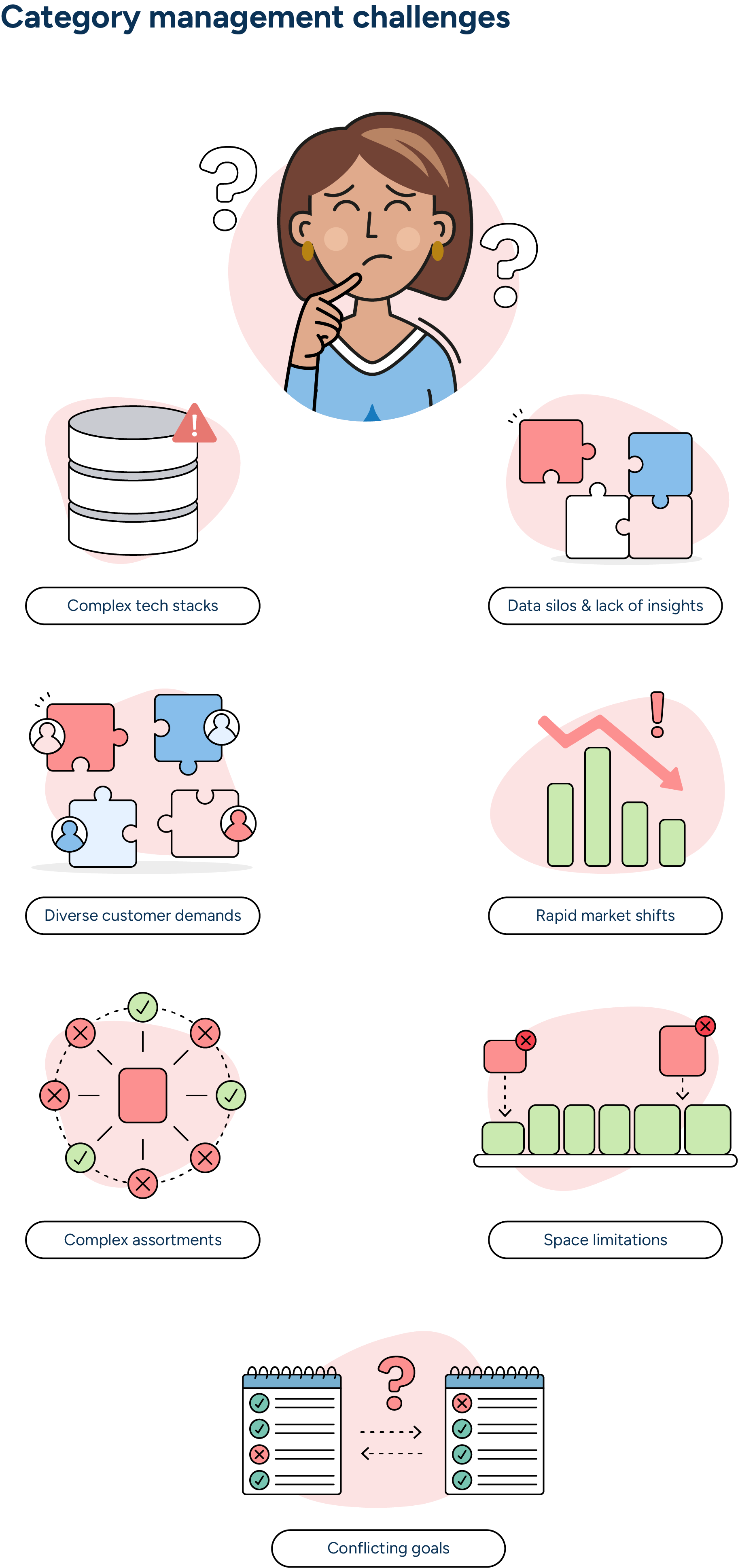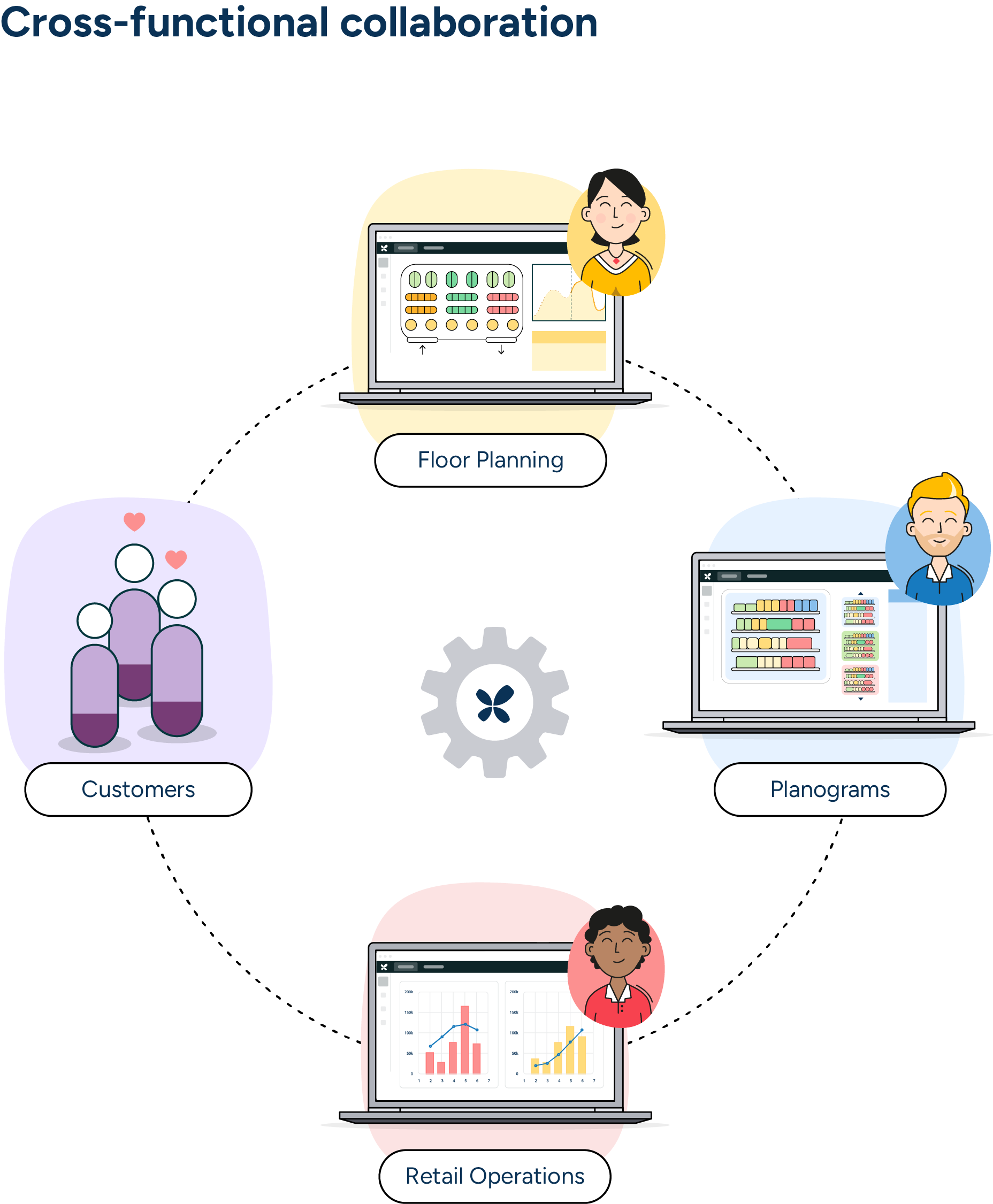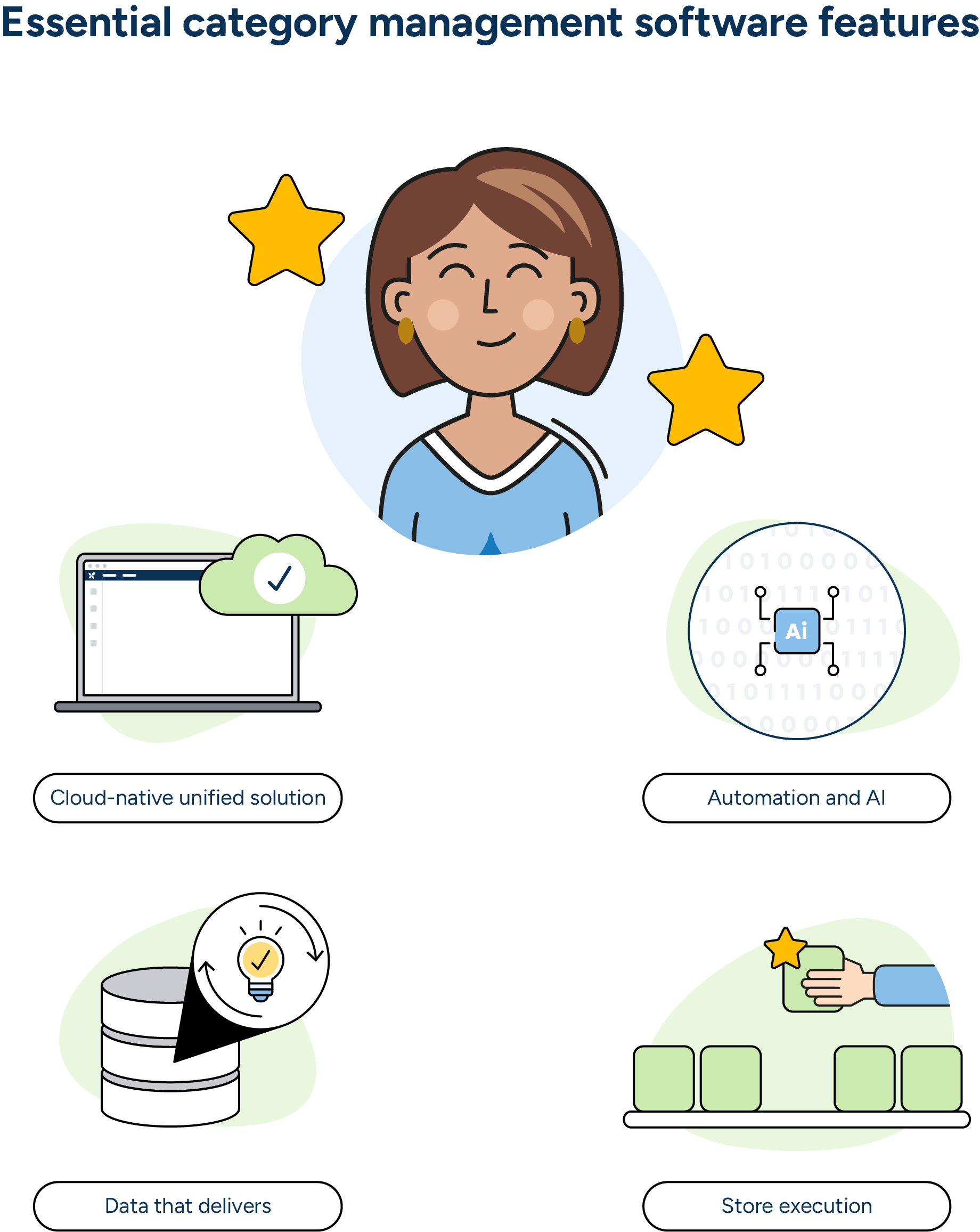Retail planning is as easy as riding a bike…with squeaky brakes…down a very steep slope. The terrain is pitted with data silos, disjointed plans, tough competition, and disruptions. Retail planners spend a lot of time trying not to faceplant into poor assortment, pricing, and promotion strategies, but sometimes it seems that lost sales and low profit margins are unavoidable.
How can companies design efficient, customer-focused product strategies? How can they get the right item on the right shelf at a price that keeps shoppers happy and profits climbing?
Category management helps retailers avoid muddy assortments, maneuver sharp demand turns, conquer pricing hills, and land the jump between strategy and execution. The right methodology (backed by the right technology) keeps operations in sync and improves efficiency and margins — while providing a shopping experience that keeps customers coming back for more.
Key takeaways
- Category management is a customer-focused approach that uses product categories to create an intuitive shopping experience that boosts profitability and customer satisfaction.
- Category management delivers improvements in terms of customer loyalty, sales, vendor relationships, and supply chain efficiency.
- Forecasts, assortments, pricing, promotions, floor plans, planograms, and store execution all play a role in overcoming category management challenges. These challenges range from data silos and market volatility to planning complexities and competing business objectives.
- With an AI-driven, automated solution that processes and analyzes network-wide data quickly, retailers align store operations with planning strategies, using up-to-date insights and a unified planning approach.
What is category management?
Category management is a customer-centric approach to retail and supply chain planning that organizes products into categories and treats each category as a separate business unit. The goal is to tailor assortment planning, pricing, promotion, space allocation, and supply chain management to ensure a seamless shopping experience tuned to customer needs. By primarily using customer behavior and shopping styles as a guide, retailers can tailor categories to specific customer needs, driving more sales and increasing profitability.
A category management team can build a strong strategy by carefully considering of the Four Ps:
- Product: What items are in our portfolio? Are there new ones being added or removed? What are the current trends, and how should we build and adjust assortments and category mixes?
- Placement: Where are we putting the product? Are there clusters of stores that require the same category mix, or are there store-specific needs to fill?
- Price: What does the competition look like? Are we looking to speed up inventory turns, or are we dealing with items with high margin targets?
- Promotions: What kinds of promotions do customers have the most positive response to? How will those promotions affect the other functions?
Keep in mind that the Four Ps are all well and good, but these plans have to be put into practice with a strong execution plan.
7 benefits of efficient category management in retail
Four Ps and a new management strategy may seem like a lot of ground to cover. But the retailers that overcome inertia and choose to define (or refine) their category management approach reap some impressive benefits:
- Increased sales and profitability. Retailers drive sales by optimizing inventory and honing pricing strategies to efficiently meet demand while lowering costs and widening profit margins. Tailoring the product mix and promotions to meet customer needs increases basket size and trip frequency.
- Better inventory and capacity efficiency. When their product mix and portfolio are tailored to customer needs, retailers reduce overstock and maximize inventory efficiency. This reduces bottlenecks throughout the supply chain, minimizing the strain on warehouse and store labor and increasing overall network efficiency.
- Improved on-shelf availability. Category refinement limits lost sales and helps stores make the most of their shelf space by allotting the right type and volume of products to the right locations around the store.
- Data-driven decision making. Category management relies on detailed analysis of sales data, market trends, and consumer behavior. This data-driven approach allows retailers to make informed decisions about product assortments, promotions, pricing strategies, and store layouts, leading to more efficient and cost-effective operations.
- Improved vendor relationships. Through closer collaboration and a better understanding of category performance, retailers and suppliers can develop mutually beneficial product and promotion strategies that drive efficiency and profitability.
- Enhanced customer satisfaction. When retailers design categories and store layouts around shopper behaviors, customers find what they need where they expect it to be, creating an effortless shopping experience and encouraging customer loyalty.
- Flexible supply chains, future-proof businesses. By monitoring trends, disruptions, sales data, and consumer behaviors, retailers can adapt to market shifts and continuously improve their product categories for more nimble, efficient, and profitable operations.
Building a cross-functional category management framework
Category management encompasses six unique but interconnected functions in retail planning. Successful category managers incorporate these disparate components into a unified, but dynamic program, integrated by flexible data-sharing technologies.

Demand forecasting
A categorization strategy groups products together to create an intuitive shopping experience, but putting that strategy into practice begins with accurate forecasting. The forecast must be granular enough to satisfy location-specific demand and flexible enough to support different levels of aggregation for better category control and insight.
An AI-based forecast helps planners achieve both speed and superhuman data analysis. Machine learning algorithms can absorb and analyze an abundance of demand influencing factors, spanning sales history, the impact of planned pricing and promotions, seasonality, weather, and more. They can do this at scale, meaning that just as they can assess a wide range of factors, they can also manage the deepening pools of data associated with each individual factor. And they perform these complex forecast calculations for each product in each location, determining optimal inventory targets for items across the retailer’s portfolio.
In this way, the forecast facilitates the execution of strategic assortment decisions and governs which products are sent to which locations, in what quantities.
Assortment planning
Assortment planning analyzes sales data, market trends, and customer feedback to identify consumer preferences. This enables category managers to define the scope of each product category at different levels of specificity and align product mixes with customer demand, making the most efficient use of resources and optimally positioning inventory. Introducing market basket analysis into this process allows for a nuanced understanding of product correlations and customer purchase patterns, further enhancing inventory precision.
By analyzing customer demand and market trends, retailers can both tailor their product offerings and conduct SKU rationalization to identify underperforming SKUs, ensuring the right products in the right place are available in each store.
Assortment planning also measures the potential impact of new product introductions (for which there is no sales history) and assigns them to the locations where consumer response will most likely be positive. This information is fed into the machine learning forecast algorithms, which calculate the most probable demand and monitor sales data going forward. Using product performance data, planners can adjust assortments as needed and calculate the impact of those changes on product mix, distribution, and customer loyalty.
Category management also reduces the threat of cannibalization by ensuring assortment plans offer enough variety but avoid spreading demand out over too many products. By analyzing the spend of core customers, category management outlines the consumer decision trees (CDTs) that ensure the right breadth and depth of an assortment plan.
Planogramming
Planogramming combines art and science to optimize retail spaces for sales performance, operational efficiency, and customer satisfaction. Retail planograms are detailed visual diagrams that specify how and where products should be placed on shelves or displays. These diagrams maximize sales and improve inventory management by organizing products in visually appealing, space-efficient ways that align with consumer buying behaviors.
Planogramming includes decisions about product grouping, shelf positioning, and the number of facings each product receives. CDTs, product affinities, sales metrics, and eye-tracking studies can help planners decide how best to use the available space. By specifying the exact quantity of each product on display, retailers can reduce stockouts and overstocks, ensuring that popular items are always available while minimizing excess inventory.
Through strategic product placement and attractive visual merchandising, planogramming can influence purchasing behavior, encourage impulse buys, and promote higher-margin products, thereby increasing sales and profitability.
It also facilitates compliance with merchandising standards by providing a clear reference for store employees when stocking shelves.
Pricing and promotion
Any strategically strong category management approach includes a constant review of product costs and the resulting impact on prices and promotions for those products. Poor pricing strategies can significantly and negatively impact consumer perception of either specific items or their entire category at large.

Category managers work hand-in-glove with the pricing and promotion teams to ensure that the right categories are promoted, discounted, and highlighted at the right times. For instance, no matter how hard you promote snow shovels in summer, the category will not perform well. While this is an extreme example, more subtle but just as relevant mistakes can be made wasting promotional dollars in the wrong place on the category map. By weaving pricing and promotions into the fabric of category management, retailers can maximize customer satisfaction without putting profitability or inventory efficiency in jeopardy.
Floor planning
Floor planning (also called macro space planning) is a critical component of category management that focuses on the physical arrangement of product categories within a store. It involves designing the store layout and placing categories in specific locations to optimize customer flow, enhance the shopping experience, and maximize sales and profitability.
Architectural store drawings allow planners to strategically arrange and allocate space within a store for different categories based on sales performance, inventory turnover, and seasonal variations. This helps maintain optimal stock levels and reduce the risk of overstocking or stockouts.
Floor planning insights help planners find the best combination of category mix, size allocation, and item placement so categories have enough space to be credible without taking up real estate that would better serve other categories. By analyzing customer shopping behavior and category affinities, teams can determine optimal category adjacencies that help shoppers make the most efficient use of their time shopping.
Store execution
The greatest plan in the world isn’t worth much if it’s never put into action. Store execution helps achieve sales targets and deliver the experience your customers expect by ensuring store alignment with updates to pricing, promotions, and planograms. Category management solutions should provide mobile applications that make it easy for employees to prioritize tasks, execute planograms, and replenish inventory. It should also provide two-way collaboration between the field and central teams, so store employees can communicate and correct planogram issues, guarding against capacity bottlenecks and inventory imbalances.

Providing store employees with the tools they need for greater efficiency reduces stress and overwork while securing an elevated shopper experience, encouraging repeat customers, and building brand reputation.
Common category management challenges
Category managers understand why category management is important and what goes into the process, but they will also inevitably run up against obstacles. It’s important they keep these challenges in mind so they can plan ways to evade or overcome them.

Precarious tech stacks
Forecasting, assortment planning, floor planning, planogramming, and store execution: In many retail networks, these functions are handled by different teams with different platforms. There isn’t one unified platform focusing and aligning the efforts of each team. Because these different systems don’t talk to each other, data remains siloed, preventing teams from collaborating.
Diverse customer preferences and rapid market changes
Category managers must be able to anticipate and meet demand across a wide spread of customer expectations – customers who can easily go elsewhere if they aren’t able to find what they need in store.
At the same time, planners must be prepared to adapt to the unexpected (but inevitable) rise and fall of trends, the latest supply chain disruption, or a sudden but extreme weather event. Categories must be pliable – sturdy enough to support typical demand but flexible enough to add or remove products strategically as needed.
Complex assortments with limited space
The diversity of consumer demands can make assortment planning an arduous task. Planners need to fit the right products (and enough of them) within the physical confines of the sales floor, making optimal use of available space and satisfying demand through on-shelf availability – without overloading back rooms and staff with excess inventory.
Conflicting internal and external objectives
Retail and supply chain planning involves multiple parties, both within an organization and outside of it. This often results in tangled communications and conflicting goals. One team may focus on supplier funding and negotiation requirements, while another team in space management has a completely different set of priorities. Company goals, business limitations, and divergent objectives all contribute to collaboration obstacles and stilted decision-making.
4 strategies for improving category management processes
Once a retailer has taken stock of goals and challenges, it’s time to funnel those insights into an actual process. Here is an outline of the strategies that should be guiding the tactical approaches to category management.
1. Take a customer-centric approach
Place the customer at the center of your category management strategy. Regularly gather feedback, conduct surveys, and analyze consumer preferences to adapt your offerings and improve the overall shopping experience. Retailers can build lasting relationships and foster loyalty by delivering products that resonate with customers. Plus, in such a competitive landscape, staying responsive to customer needs and preferences can make you a standout and create a wider, more loyal customer base.
2. Form strategic supplier partnerships
Strategic supplier partnerships can enhance insights by supplying additional data sources and even custom research. Enlisting the aid of trusted partners can reduce overall workload, freeing up decision-makers to better focus on strategy. However, when it comes to supplier relationship management, it’s important to note that even with the most trusted partners, retailers need to be aware of their partners’ goals and priorities to ensure that biases are considered.
3. Enable end-to-end, cross-functional collaboration
Gather input from all stakeholders, using their diverse roles, skillsets, perspectives, and priorities to build a more comprehensive category plan. Bringing in all available expertise and incorporating a broader picture of the business needs and challenges will help you construct a complete, fully executable, and more resilient category plan.

4. Adopt innovative technologies
Every good strategy needs the right tool. During your strategy discussions, keep track of the kinds of capabilities you’ll need by identifying the desired outcomes. Do you need stronger forecasts? Better collaboration? Improved visibility? Keep your end goals in mind so you can build a technical structure to support them.
Essential category management software features
Even as they build their plans and strategies, category managers need to consider how best to use the technological resources available to them to put these plans in motion. The right solution will underpin category management strategies by creating a unified, data-driven process that’s fast, accurate, and collaborative.

A cloud-native, unified solution
For a unified category management process, all the components need to live on one unified platform. This platform must provide end-to-end visibility and actionable insights so teams can understand the impact of decisions along the entire length of the supply chain.
With one solution bolstering operations from forecasting to store execution, companies can eliminate decisions made in silos, instead ensuring teams are collaborating, tracking product behavior, and aligning category management operations with each other and with consumer demand.
If this solution is also cloud-native, it can update in the background with minimal disruption to business and planning processes. From a user perspective, a cloud-native solution makes it easy to share data between applications. From an IT perspective, expensive upgrades involving desktop apps and servers become a thing of the past. Retailers can keep their solutions and software up to date, taking advantage of technological developments as they happen.
Automation and AI
The key to successfully adopting automation and AI is knowing how and where to use it. These tools work best for completing labor-intensive manual calculations and complex analysis of cumbersome amounts of data. The speed of these processes means that categories can be analyzed and updated faster so retailers can respond strategically to sudden market changes.
Data that delivers
Category management thrives on data. A category management strategy should rest securely on a platform that unifies data across operations, accelerating and simplifying data management by making it easily accessible and consumable for applications across the organization. The better and more unified the data, the more beneficial the insights derived from it.
These insights can lead to more refined product selection and category parameters, making the best use of available resources and capital while tuning product mixes to consumer preferences. A unified data platform eliminates error-prone manual processes by automatically integrating data across forecasting and replenishment, space planning, pricing, and promotion planning. This means updates are communicated as they happen and plans can be adjusted according to both external data and internal business decisions.
Store execution with built-in, cross-functional communication
Store execution ensures category products hit the store floor in the right amount, in the right place, in the right arrangement, and at the right price. But it’s important that the process not end there.
Store and planning teams need a tool with a direct line of communication so stores can provide feedback on how well category plans fit location-specific capacity and consumer needs. This feedback ensures that ongoing category analysis accurately identifies successful categories and corrects poor performers.
Real-world category management examples
Effective category management interweaves supply chain, merchandising, and store operations together to support a cohesive strategy, but what does this look like in practice? When category managers are given the tools outlined above, they can achieve great success. Here are two real-world examples of how prominent retailers did just that with help from RELEX.
One Stop
After a period of exponential growth, One Stop, a leading UK convenience retailer, needed to refine its localized merchandising plans. According to Mervin Nugent, Senior Range Planner at One Stop, “We needed to create targeted space and assortment recommendations in every category.” The RELEX space planning solution provides fully automated and optimized planograms that meet individual, localized store requirements and dramatically increase customer satisfaction. This enables OneStop to improve its customer-centric strategy, expanding its offerings while catering to local customers and creating a double-digit sales lift.
Circle K
Circle K, an international convenience store chain, needed to improve inventory control and assortment planning. Through an internal review, the retailer discovered there were opportunities to improve their order processes and planogram compliance. Thanks to the RELEX platform that unifies forecasting, replenishment, space planning optimization, and planogram execution, Circle K could generate and share forecast-based planograms, as well as list and delist products effectively and accurately using real-time supply chain data. The company significantly exceeded its goals in all metrics while improving availability and inventory turnover.
Backed by RELEX technology and best practices, these companies achieve an integrated category management process that continues to help them craft customer-centric product families and edit category parameters as trends develop.
Nail category management from the get-go with RELEX
Because it requires the cooperation of so many different teams and functions, effective category management needs the right technology – and the right technology partners.
The RELEX unified platform creates open channels of communication and collaboration that keep the right products flowing smoothly through the supply chain at a rate and volume suited to customer needs. It equips planning teams with specially trained AI and eases the daily grind through automation. Plus, it’s backed by the innovative and experienced minds that have made RELEX a close technology partner of over 400 companies worldwide.
With RELEX, category managers can rescue data from silos, align strategies with tactics across functions, and keep their strategies data-driven and customer-focused.
FAQs
What is category management?
Category management is a retail and supply chain planning strategy that tailors assortments, pricing, promotions, space, and inventory planning to customer needs by organizing products into categories based on consumer behaviors and treating those categories as separate business units.
Who originated the category management approach?
Brian Harris began developing the category management method in the late 1980s. By 1997, he had outlined the Brian Harris Model, the 8-step process that has become the accepted industry standard and common foundation for category management.
What are the eight steps of category management?
According to the Brian Harris Model, these eight steps help companies design profitable, customer-first categories.
- Use consumer behaviors to see what products are most often bought together and decide what products belong in what categories.
- Determine how demand and competition might shape your category.
- Track category performance compared to market trends and consumer behavior to identify challenges and opportunities.
- Determine measurable KPIs for each category.
- Construct an overall strategy for each category, bearing in mind category objectives and product behaviors.
- Determine the tactics and responsibilities of each function and department in supporting the strategy.
- Apply these best practices and protocols across your network, exchanging data across teams to respond quickly and accurately to market shifts.
- Analyze category performance, cycling through the 8-step process to refine categories as needed and tailor them to changing customer wants.









